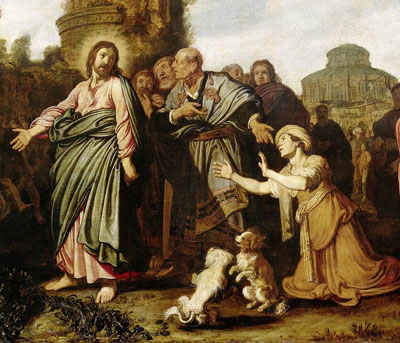
"Christ and the Canaanite Woman" -Pieter Lastman (1617)
This reflects Glen Miller’s scholarship on the story. This story (Syrophoenician woman) originated with Mark first and then was used by Matthew.
Matthew made four important modifications in Mark’s account:
- The Greek woman refers to Jesus by the messianic title "son of David" (15:22).
- At first, Jesus ignores the woman’s request and the disciples complain that she is badgering them (15:23).
- Jesus responds to them by saying that he was sent only to the lost sheep of the house of Israel, i.e., the Jews (15:24).
- After the clever repartee, Jesus responds by saying that her faith (or trust) is enormous and informs her directly that the exorcism is fulfilled (15:28).
This can be a disconcerting story in that some have interpreted Christ’s actions as "putting her off" by not listening or as unsympathetic and downright rude in another.
The context of the story is important to understand as well as the flow of the story.
Historically, Jesus is taking his disciples aside for some very needed rest. The house provided a place of retreat for Jesus with his disciples.He was trying to escape notice.He heads northward to “Tyre and Sidon,” port cities in what today would be parts of Lebanon and Syria. Canaanites were tradition enemies of the Jews. "Canaanite" was a term Jews gave to the pagan semites.
It is important to see this scripture in relationship to the Pharisees story earlier in the reading. The woman story is between the Pharisees and the disciples. The Pharisees belong to the covenant people but take offense at the conduct of Jesus’ disciples, challenge his authority, and are so defective in understanding the Scriptures that they show themselves not to be plants the heavenly Father has planted. But this woman is a pagan, a descendent of ancient enemies, and with no claim on the God of the covenant. Yet in the end she approaches the Jesus and with great faith asks only for grace; and her request is granted. This is his public ministry.
In the story the disciples are resting. She approaches from outside of house while he is inside and yells at him from the outside. He doesn’t answer her but then has a conversation with the disciples over his mission to attend to Jews first. (Theologically, Jesus was sent (as Messiah) to the Jews only. The biblical intent was that the Nation of Israel would accept the Messiah, receive the Spirit, and turn-around and evangelize/minister to the whole world (as they will some day–Romans 11.15). The Canaanite woman is not part of this conversation.
They decide to approach Jesus about her, and asks him to grant her request and send her away. She makes her appeal kneeling in front of him.
The comment over the dog was heard by both parties, the disciples and the woman . "It is not fair to take the children’s food and throw it to the dogs." She said, "Yes, Lord, yet even the dogs eat the crumbs that fall from their masters’ table."
Glen Miller writes about this : " She is not an Israelite, and although she uses the Son of David title for Jesus, probably has little or no understanding of the theological subtleties required to process the words in the same way as the disciples. But she has already had some interaction with the disciples, and they have probably told her that they are there to rest, not minister. So SHE will hear the words of Jesus and make the equivalencies of "children-disciples"//puppies-me". She will understand Jesus to be saying that she WILL GET FED, but that He must take care of His disciples FIRST. There is not a ‘NO’ in Jesus’ words at all–just an implicit "WAIT.""
Larry Broding in his blog interprets the story this way
"Jesus then made a challenging comment. He compared the Jews to children and Gentiles to dogs. [15:26] On the surface, the statement was demeaning, for the term "dog" stood atop a list of Semitic insults. "Dog" implied the cowardice of dogs who only hunt in packs. Alone, most dogs will run away when confronted.
"However, the term also implied extreme loyalty. A true pet would defend his or her master to the death if confronted. To bond with their pets, masters in Semitic households would fed their dogs from leftovers after the meal. In this way, dogs knew their place and knew their master. The after-meal time ritual helped insure the dog’s loyalty (and the family’s safety).
"Not to be deterred, the woman used Jesus’ analogy to her advantage. Referring to the well-known bonding ritual, she affirmed her trust in Jesus. She was loyal, like a family pet. She would wear the insult (if there was one) proudly. [15:27] Through her trust, Jesus acknowledged her faith and cured her daughter. [15:28]"
Jesus is doing two things at once – "bless His disciples with rest, while He heals her daughter" and (2) that the miracle she needs is a simple ‘crumb-size’ work for the Son of David! This is ‘action at a distance’ (without the physical presence of Jesus)."
"The woman, upon getting the ‘your request in granted’, maintains her great faith, and leaves without needing Jesus to return with her. Her faith has proven strong, but she has also learned something–that there will still be a big feeding time for the "puppies"–in the future. This notion of the future time for blessing of the gentiles is also present in that image, and this would have been instructional both for her personal faith, and for the theological education of the disciples–they needed to know about the later mission to the gentiles that would occur."
Note there is no statement by the woman that she considers this a "put-down" even while she achieved help for her daughter.
